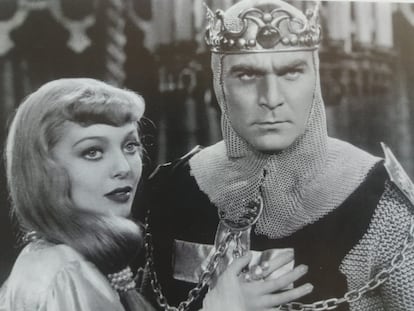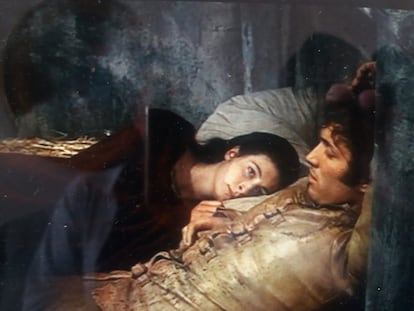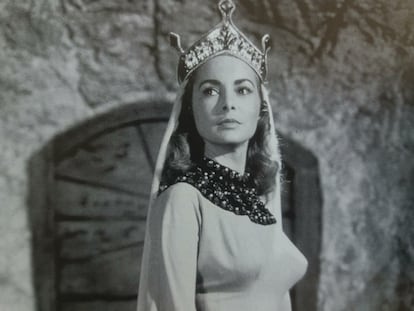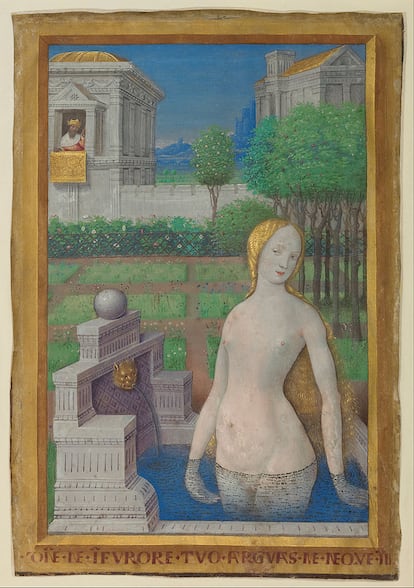No oral sex in the Middle Ages
A gripping book by British historian Katherine Harvey documents what went on between the sheets in the Middle Ages

When one thinks of medieval sex, images from classic movies tend to come to mind: John Boorman’s Excalibur, where a sexy Morgana Le Fay (Helen Mirren) in a breastplate seduces Arthur, Sir Gawain (Liam Neeson) and Merlin; Adso the novice’s (Christian Slater) first time with Valentina Vargas’s peasant girl in The Name of the Rose; the torrid relationship between the Norman Chrysagon de la Cruz (Charlton Heston) and the maiden Bronwyn, who captivated Cirlot, in The Warlord; Eric (Tony Curtis) tearing Janet Leigh’s dress so she would row better in The Vikings.; and the student Heron of Foix (Assi Dayan) and the noble Claudia (Anjelica Huston) consummating their (free) love in a deserted abbey amid the jacquerie in the rapturous A Walk with Love and Death, a curious mixture of marxism and hippie culture (it was released in 1969).
For better or for worse, some recent films – Kingdom of Heaven and The Last Duel come to mind – have probably made us reflect on what Middle Age sexuality was like. In the former movie, the amorous encounters of Balian of Ibelin (Orlando Bloom) with the Orientalized Sibyl of Jerusalem (Eva Green) were a paean to the fusion of cultures, while the violence that the latter movie radiated, in which the contest seemed to begin in bed, made one think that people always wore armor during the medieval period, even when they were at home.
In reality, we only have vague and contradictory ideas about sex in medieval times. That’s why British historian Katherine Harvey’s book The Fires of Lust: Sex in the Middle Ages is so interesting. Harvey begins by debunking some persistent myths about sex in the Middle Ages, such as beliefs that medieval times resembled a Game of Thrones-like “anything goes” scenario; that the period was defined by the droit du seigneur (as in Warlord); or that it was governed by the chastity belt (which calls to mind Monica Vitti in On My Way to the Crusades I Met a Girl Who…. In the scene, she sits down in a rage with a clanging sound after her husband – who is leaving to join the Crusades – puts the contraption on her. But the historian also warns that it would be a mistake to believe that Europeans between 1100 and 1500 had sex in the same way we do, even if sex is a universal human impulse. While the human body and its physical capabilities have not changed much over the past millennia, she argues that there have been significant transformations in how people view, understand and experience sex.
One fundamental distinction is the medieval tendency to emphasize active (implicitly male) and passive (female) sexual roles. Sex was something that men did to women. That doesn’t mean that the medieval woman was just expected to lie on her back and think of England, although it was significant that the man did the penetrating while the woman was penetrated. In fact, sex between women was only considered to be sex if one of them used an object to penetrate the other. Other forms of sex between women were legally unknown, and it appears that many people did not really understand what they could do with each other.

Back then, people knew less about sex than we do now. These days, we have the internet. In the Middle Ages, men had yet to discover the clitoris (they found it during the Renaissance period). Apparently, people masturbated very little during the Middle Ages; there is almost no evidence of it (although one cannot imagine Ivanhoe or Richard the Lionheart talking about such things).
Other sexual practices that are relatively commonplace today are similarly absent from the historical record, indicating that they were very rare during the Middle Ages. Harvey notes that there are no traces of oral sex in the documents. “It may be that it seemed especially repugnant to a society that associated the upper body with God and morality, while the lower body was linked to filth and sin. To put the mouth in direct contact with the genitals was to defile an organ [the mouth] made for better things.” It is possible that a lack of hygiene played a role here. It seems that interfemoral intercourse – sex with the penis between the woman’s legs but without penetration – was very popular. That method, however, was frowned upon in homosexual male sex: in 1357, Nicletus Marmanga and Johannes Braganza were sentenced to death at the stake for engaging in the practice.

Informed by Roman Catholic Christianity and Galenic medicine, medieval sexual knowledge was concerned about questions such as whether Adam and Eve had sex in paradise, whether she menstruated before the Fall, and whether he had wet dreams. These weren’t minor issues; they were of great concern to the abbess and scholar Hildegard of Bingen and especially to St. Augustine, who believed that all sex was sinful, and that orgasms made you stupid. The obsession with (female) virginity was such that the mystic Margery Kempe thought only of being a virgin, despite having birthed 14 children. However, from a health perspective, it was thought that some sex was good for a woman. According to the medieval theory of humors, women were cold by nature, and sex provided a woman with warmth. Defloration was a critical moment. Women were subject to virginity tests, and women devised ingenious methods to bypass them, such as putting leeches in their vagina the day before the wedding to deceive their husbands with the flow of blood that night.
If properly performed, marital sex was not considered an obstacle to salvation; wisely, it was understood that total abstinence would mean the end of the human race. But there were certain rules people needed to obey. For instance, men had to avoid excessive effort during sex; that was considered adultery with one’s own wife. Women had to comply with their marital duties and could only refuse sex in certain cases, such as when the husband was crazy, to avoid having intercourse in a sacred place (if one had sex in a church, one had to re-consecrate it), or when the husband wanted to commit sodomy. If a woman’s husband was crazy and wanted to take her from behind in a church, the law supported her decision not to participate. However, if a woman’s husband was a leper, she had no excuse for not meeting his sexual needs. The concept of marital rape did not exist in the Middle Ages.

Harvey notes that the confluence of all these ideas must have caused many women to suffer. For example, the author cites a special dispensation to remarry that Pope Alexander III gave one man after he hurt his wife so badly on their wedding night that she was rendered permanently unable to have sex again.
Surprisingly, penalties for sexual violence did exist in the Middle Ages, but, as Harvey emphasizes, they were not widely enforced. For example, in many jurisdictions, rape was punishable by death. However, there are no known cases of any Englishman being executed for that crime during medieval times. In fact, marriage between the rapist and the victim was regarded as a good solution.
Medical theory considered women to be defective men. Menstruation was seen as disgusting and dangerous, but menopause was even worse; it was widely believed that bad substances remained in the body after women’s periods ended. For its part, semen was associated with brain matter.
Magic was thought to make men impotent, a matter the authorities took very seriously. Indeed, in 1390, two Parisians, Margot de la Barre and Marion la Droiturière, were sentenced to be burned at the stake for rendering the latter’s former lover useless with his new wife.

People generally believed that women could only get pregnant through sex in the missionary position. It was commonly suggested that a man should stay on top of the woman for at least an hour, even if he (or she) was bored. Women were believed to produce a seed when they orgasmed. Common wisdom in the Middle Ages held that men and women needed to climax almost simultaneously (ladies first) for conception to occur.
More interesting positions during sex could cause physical defects in the babies; some circumstances could even cause a woman to give birth to a toad. Sex with the woman on top and sex from behind were regarded as particularly egregious positions; the latter was associated with animals. Women who had twins were believed to have been with two men. Sometimes, adultery was punished with severe penalties, including death.
In the early Middle Ages, bestiality was considered a minor crime, the equivalent of masturbation. But as the belief in witches and their dealings with the devil in the form of an animal became official thought, sex with an animal came to be both a sin and a crime of heresy. At that point, it was customary to execute both the sinner and the animal.
For example, Harvey cites the interesting case of a Venetian artisan who was accused of having carnal relations with his goat. To mitigate his guilt, the man claimed that an accident had left him unable to have intercourse with a woman or masturbate. A team of doctors examined him, while a judge authorized two prostitutes to perform a number of experiments on him. Between them, they concluded that he could get erections but did not feel anything from them. He was declared to be a sodomite with extenuating circumstances. He was branded, bludgeoned and had a hand cut off but escaped the death penalty. Harvey notes that “the fate of the goat is unknown.”
Medieval Europe had clear ideas about feminine beauty: among the desirable features were blond hair, fair skin, rosy cheeks, a small red mouth, long limbs and a narrow waist. Although some have suggested that the bosom was purely maternal, evidence shows that people saw breasts in sexual terms: the aesthetic ideal was small, round, firm breasts. For example, Bathsheba - with whom King David committed adultery after he saw her bathing - represented the period’s ideal of female beauty; she was depicted with those characteristics. In contrast, an ample bosom gave women a bad reputation. Medieval medical texts explain methods for reducing breast size, such as rubbing it with blood from piglet testicles, but they never offered strategies for becoming more buxom. Additionally, evidence shows that medieval women wore undergarments that made their breasts appear smaller.

The ideal man was tall, strong, well-proportioned and pale-skinned. Hair was considered a sign of virility to such an extent that some men wore false beards and few shaved. It was generally assumed that women liked well-endowed men, and literature is replete with ladies obsessed with male genitalia.
Tu suscripción se está usando en otro dispositivo
¿Quieres añadir otro usuario a tu suscripción?
Si continúas leyendo en este dispositivo, no se podrá leer en el otro.
FlechaTu suscripción se está usando en otro dispositivo y solo puedes acceder a EL PAÍS desde un dispositivo a la vez.
Si quieres compartir tu cuenta, cambia tu suscripción a la modalidad Premium, así podrás añadir otro usuario. Cada uno accederá con su propia cuenta de email, lo que os permitirá personalizar vuestra experiencia en EL PAÍS.
¿Tienes una suscripción de empresa? Accede aquí para contratar más cuentas.
En el caso de no saber quién está usando tu cuenta, te recomendamos cambiar tu contraseña aquí.
Si decides continuar compartiendo tu cuenta, este mensaje se mostrará en tu dispositivo y en el de la otra persona que está usando tu cuenta de forma indefinida, afectando a tu experiencia de lectura. Puedes consultar aquí los términos y condiciones de la suscripción digital.
More information
Últimas noticias
Welcome to the post-religion era: The idea of Christianity as the absolute truth has become obsolete
‘I thought you would like it’: The risky sexual practice popularized by TV shows and TikTok
The digitalization of tourism: ‘They promise experiences and gave us the worst possible one’
Mexican peso defies uncertainty with forecasts of a new period of stability in 2026
Most viewed
- Sinaloa Cartel war is taking its toll on Los Chapitos
- Oona Chaplin: ‘I told James Cameron that I was living in a treehouse and starting a permaculture project with a friend’
- Reinhard Genzel, Nobel laureate in physics: ‘One-minute videos will never give you the truth’
- Why the price of coffee has skyrocketed: from Brazilian plantations to specialty coffee houses
- Silver prices are going crazy: This is what’s fueling the rally











































